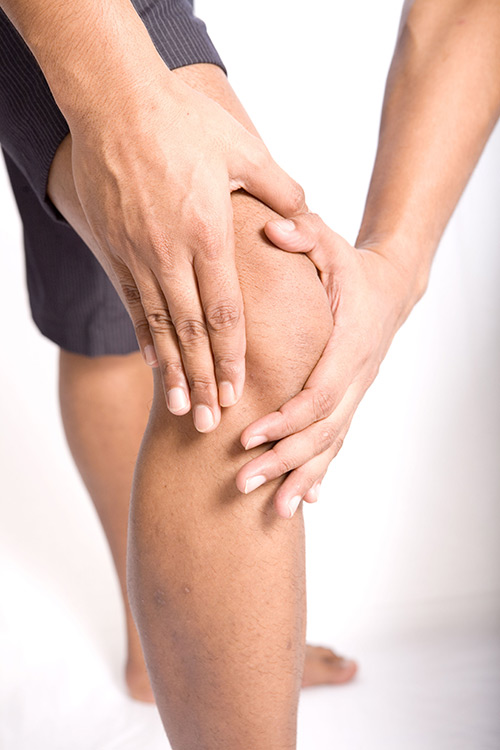Knee Symptoms
 What Is Inflammation?
What Is Inflammation?
The word "inflammation" literally means to "set on fire." Its characteristics are swelling, reddening, pain, and heat. Inflammation is a defensive reaction to injury. There are hundreds of inflammatory processes, as indicated by the "-itis" suffix. Tendinitis, bursitis, and arthritis are conditions that bring about inflammation in the knee.
What's good about inflammation? Each characteristic of inflammation provides a clue. The reddened appearance of inflamed tissue is a result of an increased blood supply. This carries white blood cells to the affected tissues. These are the agents that release enzymes to aid in healing or destroy germs.
This extra concentration of blood cells and fluid causes the area to swell, while increased local metabolism increases warmth. Pain occurs as a result of these processes and often prompts one to seek care. Inflammation may be present in both acute and chronic knee problems.
Why do I have knee pain?
If you have knee pain, rest assured you are far from alone. Each year, 6 million Americans seek medical help for painful knees. This translates into 2.5 percent of the U.S. population sitting in doctors' offices for relief of knee pain. Even more people self-diagnose and treat themselves with pills and home remedies.
The knee is a complex mechanism that absorbs shock as we jump and is extremely flexible, permitting changes in direction while running at high speeds. It is made of ligaments, which provide support, and muscles for strength. It is a well- lubricated mechanism that functions reliably unless unduly twisted, bruised, or broken. When this happens, problems occur.
The knee is the most commonly injured joint treated by orthopedic surgeons, representing 26% of orthopedic business, followed by spine and hip injuries.
 Which knee pain symptoms are an emergency?
Which knee pain symptoms are an emergency?
Does your knee crack and click as your leg goes through a range of movements? If so, you may be worried that it is broken. Sound alone is a bad indicator of trouble. Provided there is no accompanying swelling or pain, clicking sounds are typically harmless.
Pain can also be misleading. Sometimes a knee with a serious problem has little or no associated pain, while a relatively healthy knee may display troubling signals following something as routine as a change in weather.
Generally speaking, the intensity of pain and how rapidly it comes on are good indicators of the severity of a knee problem and the need to seek care. Extreme knee pain after falling down or hearing a pop from your knee area could mean a fracture or a torn anterior cruciate ligament.
Fractures are the most typical injury to require a trip to the emergency room. Whether the result of sports or a vehicular accident, these typically require immediate care. A fracture may extend horizontally across the bone or spiral down its length. At times, the bone breaks into many parts; these are labeled comminuted fractures.
Often, the fracture fragments remain in normal alignment with each other. These are called non-displaced fractures, meaning that the bone is broken but remains in its proper position. On the other hand, there are displaced fractures in which the bony fragments have broken apart and fallen out of alignment, often distorting the shape of the leg.
These fractures have to be "reduced" and often are immobilized with a cast. At times, because of the number of fracture fragments or the tenuousness of the reduction, fractures require surgery. The orthopedic surgeon makes an incision, takes hold of the bony fragments and manipulates them back into position, typically securing them with a rod or plate and screws.
Finally, there are "open" fractures. Not only is the bone fractured, but the overlying skin is cut. This opening in the skin lets in dirt and bacteria. Without prompt treatment an infection may occur.
The two most disastrous types of fractures are spiral fractures, where extreme rotational twisting has created a break line that goes up and around the bone like a spiral staircase, and comminuted fractures. Comminuted fractures are the worst possible kind of fracture. They often happen when the knee is slammed into a dashboard in a car accident, causing the bone to shatter into many pieces. In some cases, the leg might be saved in a complex surgery where a metal rod called an intramedullary nail is used to reconstruct the leg and retain its same length.
For simple fractures, the doctor may perform "a closed reduction," in which the bone is manipulated back into proper placement without an incision through the skin, and then a cast or brace is used to immobilize the leg while it heals. For nondisplaced fractures, no reduction may be needed before the leg is immobilized.
Complex fractures may require "an open reduction," in which an orthopedic surgeon makes an incision in the leg, and, during surgery, manually repositions the bones into the proper position so they can heal correctly.
Indicators of a serious problem
- The pain is very intense.
- The pain comes on very strong and suddenly.
- You hear a pop from your knee area.
Misleading symptoms
Sounds:
If you hear grinding in your knee as you flex and extend your leg, you may think you have a knee problem. However, in some cases, that grinding sound may be normal, especially if there is no associated pain or discomfort. Noises, when accompanied by pain, should always be taken seriously.
You should have a knee specialist check them out to be sure you are not doing further damage to the knee joint. A loud pop, for example, that comes from an abrupt physical movement during basketball or tennis, can signal a torn anterior cruciate ligament. There may also be a feeling of instability or nausea. A torn ACL is very serious and needs the attention of a knee specialist promptly.
* Pain:
Some serious problems are not even painful at first. Generally speaking, the immediate onset of pain is a sign that something serious is wrong, and you need to see a knee expert. But also be aware that sometimes serious problems can develop that DO NOT produce excruciating pain.
*Note:The more of these symptoms you exhibit and the more intense they are, the worse the problem could be.
Are knee fractures common?
Often, knee pain is the result of an accident, such as a fall or a car crash. Fractures are common. According to the American Academy of Orthopedic Surgeons (AAOS), over a lifetime, each American will suffer two fractures. Many of which will occur at the knee. However, trauma represents a relatively small percentage of knee problems.
The vast majority of knee problems result from repetitive trauma. The frequent wear and tear causes cartilage or joint surfaces to become slowly damaged over time, such as chronic arthritis of the knee joint. This leads to pain and reduces the flexibility of the knee. Over half of all knee pain may be tied in some way to arthritis.
Why can't the knees stand up to these demands? Any mechanical device can and will fail if placed under undue strain.
I hurt my knee in an accident. What do I do now?
Sometimes, knee pain is the result of an accident, such as a fall down stairs or the knee being banged into a dashboard during a car accident. But this is in a relatively small percentage of cases. The vast majority of knee problems develop not from a single accident or fall, but rather over a period of years. In these cases, the knee becomes like a creaky or unstable hinge that doesn't get better, either because components in the knee are weak or unstable, or the lubricating pads and bone surface have been damaged over time.
That's the bad news. The good news is that of all the bum knees that come limping into doctors' offices every year, only 20 percent will need surgery. Of those who don't need surgery, most will get better with time. Anti-inflammatories and specialized exercises that increase range of motion, flexibility, strength, and resistance to future knee strain are usually prescribed. Sometimes knee braces are also used. That's positive news to focus on.
Aside from car accidents, slips, and falls, knees are injured merely from hauling us around all day long. Although we want to stay active, Americans are eating more. The U.S. Government estimates that 56 percent of Americans are now classified as overweight. This extra weight puts an extra load on aging knees.
How a doctor diagnoses knee problems
When a patient visits a knee specialist to help diagnose a knee problem, there are three parts to the examination: the medical history, the physical examination, and diagnostic imaging.
 During the medical history, the knee surgeon will try to find out if you have developed your problem heredity, through lifestyle habits, or a sudden sports injury. This will give the physician the best idea of how to find out exactly what is wrong and then suggest proper treatment of the injury. You should indicate to your doctor if you have been using steroids since they can cause joint inflammation. Lyme Disease from the deer tick and rheumatoid arthritis can also trigger joint inflammation, for instance.
During the medical history, the knee surgeon will try to find out if you have developed your problem heredity, through lifestyle habits, or a sudden sports injury. This will give the physician the best idea of how to find out exactly what is wrong and then suggest proper treatment of the injury. You should indicate to your doctor if you have been using steroids since they can cause joint inflammation. Lyme Disease from the deer tick and rheumatoid arthritis can also trigger joint inflammation, for instance.
Following the medical history, your doctor will give a physical examination to see if he can hear or feel what is wrong. This portion of the exam is somewhat like a carpenter trying to find out why a hinge on a door is squeaking or is not properly aligned by opening and closing the door a few times to listen to what is going on. This will show the doctor which tests he or she should perform to find out the cause of your pain.
Next, the physician may have an MRI or x-ray image taken of your knee. An x-ray often does not provide the clarity needed to see precisely what is wrong. In these instances, an MRI or CT Scan is used. X-rays, for example, only show bones. MRI and CT scans show soft tissues.
